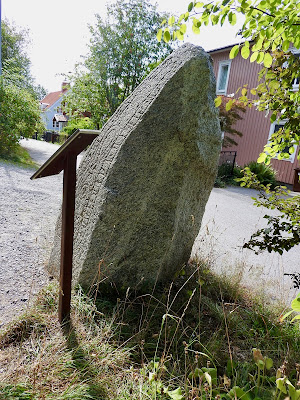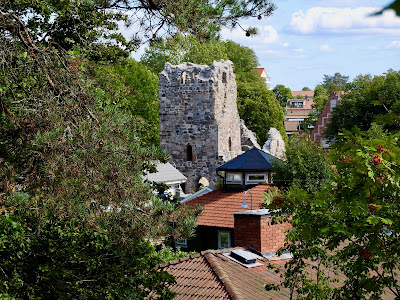目次 / Contents
1) ルーン石碑を追って / Follow Runestones
2) ランスティゲン通りのルーン石碑 / Runestones on Runstigen Street
3) 再び、丘へ / To the Hill Again
1) ルーン石碑を追って / Follow Runestones
私と夫Rは、ストックホルム市内から、シグトゥーナへ日帰り旅行をしました。
私と夫Rは、ストックホルム市内から、シグトゥーナへ日帰り旅行をしました。
シグトゥーナは、スウェーデンで最古の町と言われています。
シグトゥーナのルーン石碑は、発掘された小さな破片も数え、町だけで40をはるかに超える数が記録されています。
自治体全体を含めると、この数は170に増えます。
町の散策マップには、10個のルーン石碑が記されています。
私達は、マップを片手に、ルーン石碑を追って、町を歩きました。
Follow Runestones
I and my husband R were on a day trip from Stockholm to Sigtuna.
Sigtuna is said to be the oldest town in Sweden.
The more than 40 Sigtuna Runestones recorded includes small fragments unearthed just from the town.
The number rises to 170 when including the whole municipality.
There are 10 Runestones on the town walk map.
We walked through the town, 'Follow Runestones' with the map.
今までの日帰り旅行については下記。 / For previous day, below.
 |
散策マップ
6. 聖ローランス教会遺跡
7. 鐘楼
8.聖ピーター教会遺跡
私達はプレストガタン通り(Prästgatan) から、
ランスティゲン通り (Runstigen) へ入りました。
2つの通りの角には図書館があります。
Walking Map
6. St. Lars Church Ruins : Saint Lawrence Church Ruins
7. Belfry
8. St Peter's Church Ruins / Sankt Per's church Ruins
We turned onto Ranstigen street from Prestagtan street.
There is a library on the corner of the two streets.
 Runic stones : Runestone : ルーン石碑 (博物館の資料 / Museum materials : ★)
"私たちのルーン文字の碑文はスウェーデン語で最も古く、
シグチューンほど多くを誇る町は他にありません。
ここでは、合計10個の完全な石と約20個の破片を見つけることができます。
|
Runestones on Runstigen Street
シグトゥーナ は、ヴァイキング時代 (Viking Age / 793 - 1066) から、中世時代の1200年頃まで100年以上に渡って栄えました。
Sigtuna had flourished for over 100 years, from the Viking Age (793 - 1066) to the 1200s of the Middle Ages.
 |
ランスティゲン通りのルーン石碑 393
右の道は時計丘 (Klockbacken) へ続いていますが、
この時私達は、そのことは知りませんでした。
Runestone 393 on Runstigen Street
The path on the right leads to the Clock Hill (Klockbacken),
which we didn't know about at this time.
 1,000年! この石碑は、約1,000年の間、同じ場所にあると言われています。 すごい! 1,000 Years! It is said this stone has been the same place for about 1,000 years. WoW!   シグトゥーナはキリスト教の町として設立されましたが、 この模様はケルティック風です。 Sigtuna was founded as a Christian town, but the pattern is Celtic style. |
 |

"Ofegは、彼の2人の姉妹、ToraとRodviを記念してこの石を建てました。
OfæigRは「長い人生を送る運命にある」という意味であり、
ルーン石碑では非常に一般的です。
Roðviはゴットランド語の名前であり、これはスウェーデン本土の
ルーン石碑の唯一の例です。
ToraはTorhild、Thorgunnなどの短縮形の名前です。
これは、兄弟によって2人の姉妹を記念して建てられた唯一のルーン石碑です。
ルーン石碑はおそらくバイキング時代からここに建っており、
当時この道は、シグトゥーナの町から、北方のウップランド地方の中心部 につながっていました。 (ウップランドは、日本的にいうと隣の県という感じです)
"Ofeg had this stone erected in memory of his two sisters, Tora and Rodvi.
OfæigR means ‘destined for a long life’ and
is quite common in the runic inscriptions.
Roðvi is a Gotlandic name and this is the only example
in the runic inscriptions of mainland Sweden.
Tora is a shortened form of names like Torhild, Thorgunn.
This is the only rune stone erected in memory of two sisters by their brother.
The rune stone stands probably on its original site by the road, which during the Viking Age led northwards from the town to the central parts of Uppland."
|
3) 再び、丘へ / To the Hill Again
 |
| ルーン石碑を離れて丘への登ります。 Leaving the Runestone and climb the hill. |
 |
| どこへ出るかわからない道を歩くのは、ドキドキしつつも、ワクワクします。 Walking on a route where I don't know where to go is nervous but exciting. |
 |
そうそう、下ばかりでなく、上も見て!
ほら、赤い実がある!
Oh yeah, look not only down, but also up!
You see the red fruit! |
 |
| まだまだ続く! / Still Going On! |
 |
| 開けた場所に出て、ちょっとほっとしました。 I came out to the open place and was a little relieved. |
 |
| 私にはちょっと不思議な空間に思えました。 It seemed a little mysterious to me.  |
 |
| 岩肌がまた見えました! そして、小さな屋根も見えます!? I could see the rock surface again! And I can see the small roof!?  |
 |
| あれっ?鐘楼が! ここで、さっき来た丘を違う道から上がってきたとこに気がつきました。 What? The Belfry! Here, I noticed that we were climbing up the same hill, but we came along a different path. |
 |
聖ローランス教会遺跡 の塔が見えました。
I saw the tower of St. Laurence Church Ruins / Sankt Lars kyrkoruin.
|
大昔、シグチューナの若者たちは、楽器を丘まで運び、一晩中ここで踊っていたそうです。
A long time ago, young Sigtuna people carried their instruments to the hill and danced here all night.
 |
| 今も、ここで人は集まるのかもしれません。 People may still gather here. |
 |
戻ります。/ Will Return. |
 |
| ルーン石碑393の手前に小さな道を見つけました。 こちらを下って行きました。 I found a small path before Runestone 393. We went down here. |










0 件のコメント:
コメントを投稿